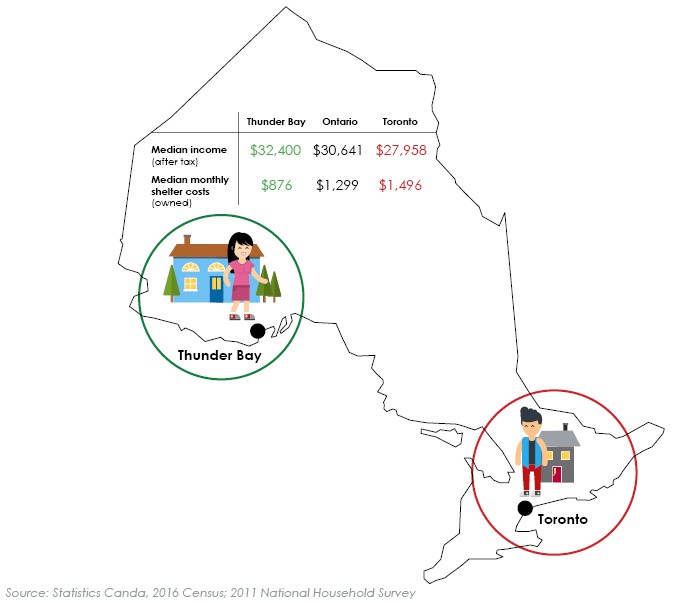TBay vs. TDot
May 16, 2019 - This blog first appeared in the January edition of The Walleye

We've all heard that the high costs of gas, electricity and food make living in the North unaffordable, but is it true? Let’s take a look at some cost of living indicators to find out how Thunder Bay stacks up against the rest of the province.
To dispel a common myth, living in Thunder Bay does not mean making less money than you could make elsewhere. In 2015, the median earner in Thunder Bay actually made 5.7% more than their provincial counterpart, and almost 16% more than the median earner in Toronto.
To explore the affordability of housing, we use “shelter costs” as an indicator. Shelter costs include all mortgage/rent/condo fees, as well as property taxes and utilities, including heat and electricity. With all these costs factored in, in 2015 the median Thunder Bay homeowner saved $423 a month compared to the provincial median. That's $5,076 over the course of the year, and $7,440 less than a Toronto homeowner. There was a similar difference in the 2011 National Household Survey, and, if it held for the years in between, the median Thunder Bay homeowner could have saved upwards of $25,000 on their home compared to their provincial equivalent. The gap in price is much closer when it comes to renting, but the median renter in Thunder Bay still paid less than 70% than the median renter in Toronto.
The median value of a home in Thunder Bay is roughly $170,000 less than the provincial median, and about $371,000 less than in Toronto. Not only are homes in Thunder Bay less expensive, but they are generally bigger. Thunder Bay homes average nearly one-and-a-half extra rooms compared to Toronto homes, and for about a third of the price. Between the similar incomes, and much lower home prices, a person can pay off a mortgage more quickly in Thunder Bay than many other places in the province.
Given these favourable income and housing statistics, it's no surprise that Thunder Bay fares better than average for affordable housing. According to Statistics Canada, 30% or more of a household’s income being spent on shelter costs indicates unaffordable housing. In Ontario, 19.8% of homeowners are living in unaffordable housing, compared to only 10.2% of homeowners in Thunder Bay. And in Toronto, a whopping 27.4% of homeowners are living in unaffordable housing.
It seems that Thunder Bay residents have significantly lower shelter costs than the rest of the province, while earning a comparable income. Stay tuned for NPI's upcoming commentary exploring how these, and other costs, compare for a family of four in cities throughout the province.
This data was collected as a part of an upcoming NPI commentary by Anthony Noga, “A Tale of 10 Cities: Cost of Living Comparison between Northern and Southern Ontario”. If you’d like to learn more, sign up for NPI’s updates on our website, www.northernpolicy.ca, to be notified as soon as the commentary is released.
Anthony Noga is a Research Analyst at NPI.
The content of Northern Policy Institute’s blog is for general information and use. The views expressed in this blog are those of the author and do not necessarily reflect the opinions of Northern Policy Institute, its Board of Directors or its supporters. The authors take full responsibility for the accuracy and completeness of their respective blog posts. Northern Policy Institute will not be liable for any errors or omissions in this information, nor will Northern Policy Institute be liable for any detriment caused from the display or use of this information. Any links to other websites do not imply endorsement, nor is Northern Policy Institute responsible for the content of the linked websites.
Northern Policy Institute welcomes your feedback and comments. Please keep comments to under 500 words. Any submission that uses profane, derogatory, hateful, or threatening language will not be posted. Please keep your comments on topic and relevant to the subject matter presented in the blog. If you are presenting a rebuttal or counter-argument, please provide your evidence and sources. Northern Policy Institute reserves the right to deny any comments or feedback submitted to www.northernpolicy.ca that do not adhere to these guidelines.
